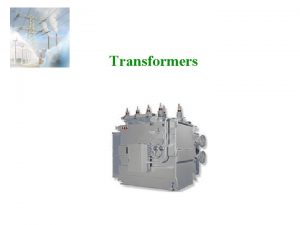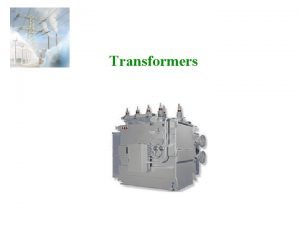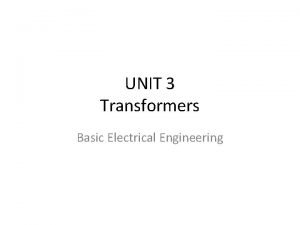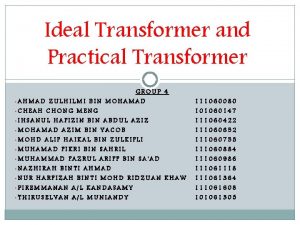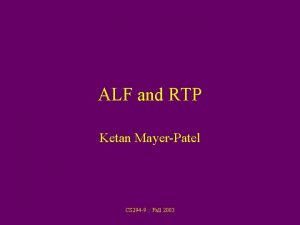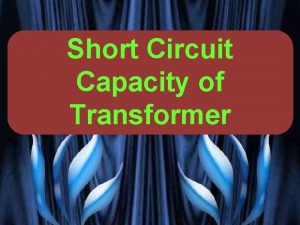Transformer Efficiency VG PATEL TRANSFORMER ENCYCLOPAEDIA TRANSFORMER EFFICIENCY





















- Slides: 21

Transformer Efficiency VG PATEL

TRANSFORMER ENCYCLOPAEDIA TRANSFORMER EFFICIENCY Thursday, February 18, 2021 PROF. V. G. PATEL 2

TRANSFORMER ENCYCLOPAEDIA TRANSFORMER EFFICIENCY What is Efficiency? Efficiency of any operation is a measure of useful work output compared to the work input. The losses in a transformer are essentially very small and the efficiency of large transformers is over 99%. Even with small transformers, efficiencies of 97% or 98% are usual. There are two main losses in a transformer, namely, the iron losses and the load losses. The iron loss is normally taken as constant at all loads, whereas the load loss is proportional to the square of the load. Transformer efficiency will be maximum when Load Losses = Iron Losses. Thursday, February 18, 2021 PROF. V. G. PATEL 3

TRANSFORMER ENCYCLOPAEDIA TRANSFORMER EFFICIENCY What is Efficiency? Efficiency of any operation is a measure of useful work output compared to the work input. Efficiency = Useful electrical energy output Total electrical energy input %η = (Output / Input) x 100 = [Output / (Output + Losses)] x 100 = [(Input – losses) / (Input)] x 100 % η = Thursday, February 18, 2021 PROF. V. G. PATEL 4

TRANSFORMER ENCYCLOPAEDIA TRANSFORMER EFFICIENCY Transformer efficiency may be defined as the ratio between Output and Input. On specified Power factor and load, the Transformer efficiency can be found by dividing its output on Input. But the values of both input and Output should be same in unites (i. e. in Watts, kilowatts, megawatts etc) Efficiency = η= Output / Input Efficiency = η= Output / (Output + Losses) Efficiency = η= Output / (Output +Cupper Losses + Iron Losses) Efficiency = η = 1 – (Losses /Input) As we know that the rating of Transform is expressed in k. VA not in k. W. But the efficiency doesn’t depend on VA i. e. it would be expressed in Power Watts (k. W) not in k. VA. Although, the Losses are directly proportional to VA (Volt-Amperes), thus, efficiency depends on Power factor on every kind of VA load. And the efficiency would be maximum on unity (1) Power factor. Thursday, February 18, 2021 PROF. V. G. PATEL 5

TRANSFORMER ENCYCLOPAEDIA TRANSFORMER EFFICIENCY The intensity of power loss in a transformer determines its efficiency. The efficiency of a transformer is reflected in power (wattage) loss between the primary (input) and secondary (output) windings. Then the resulting efficiency of a transformer is equal to the ratio of the power output of the secondary winding, PS to the power input of the primary winding, PP and is therefore high. An ideal transformer is 100% efficient because it delivers all the energy it receives. Real transformers on the other hand are not 100% efficient and at full load, the efficiency of a transformer is between 94% to 96% which is quiet good. For a transformer operating with a constant voltage and frequency with a very high capacity, the efficiency may be as high as 98%. The efficiency, η of a transformer is given as: Thursday, February 18, 2021 PROF. V. G. PATEL 6

TRANSFORMER ENCYCLOPAEDIA TRANSFORMER EFFICIENCY The losses in a transformer are essentially very small and the efficiency of large transformers is over 99%. Even with small transformers, efficiencies of 97% or 98% are usual. There are two main losses in a transformer, namely, the iron losses and the load losses OR I 2 R losses. The iron losses are normally taken as constant at all loads, whereas the I 2 R loss is proportional to the square of the load. The efficiency losses occur in the primary and secondary coils of the transformer, the component of loss is called coil loss or load loss. Coil loss or load loss is a function of the resistance of the winding materials and varies with the load on the transformer. Thursday, February 18, 2021 PROF. V. G. PATEL 7

TRANSFORMER ENCYCLOPAEDIA TRANSFORMER EFFICIENCY The efficiency of a transformer changes with the load (and load factor). The efficiency reaches its maximum value when the copper losses (a 2 Psc) become equal to the iron losses (Po). [In other words, when the short-circuit losses (a 2 Psc) become equal to no-load losses Po]. This condition is the guiding factor for -designing the transformer for maximum efficiency at most average load factor. -for economical loading of transformers in sub-station for operation at maximum efficiency. The efficiency of a transformer reduces rapidly at lower loads than the load for maximum efficiency. While designing a transformer, the weights of iron and copper are selected such that copper loss is equal to iron loss for average transformer load factor. This ensures high efficiency during the operation. For maximum efficiency, Load at which two losses are equal = Thursday, February 18, 2021 PROF. V. G. PATEL 8

TRANSFORMER ENCYCLOPAEDIA TRANSFORMER EFFICIENCY If a transformer is designed for full load I 2 R losses equal to four times iron losses, the efficiency is maximum at load factor 0. 5. The efficiency of a transformer reduces rapidly at lower loads than the load for maximum efficiency. While designing a transformer, the weights of iron and copper are selected such that load loss is equal to iron loss for average transformer load factor. This ensures high efficiency during the operation. The maximum efficiency of a transformer occurs at a load factor at which the iron losses are equal to the load losses. This is the condition for maximum efficiency of a transformer. In other words, for maximum efficiency, Core Loss = Short-circuit Loss. Iron Loss = Load loss. Thursday, February 18, 2021 PROF. V. G. PATEL 9

TRANSFORMER ENCYCLOPAEDIA TRANSFORMER EFFICIENCY Percent Efficiency As with any other energy conversion device, the efficiency of a transformer is the ratio of energy delivered to the load divided by the total energy drawn from the source. Percent efficiency is expressed as: %efficiency = L·k. VA·cosθ· 105 L·k. VA·cosθ· 10 3+NLL(w)+ L 2. LL(w) where cosθ is again the power factor of the load, therefore k. VA cosθ is real energy delivered to the load. NL is the no-load loss, and LL is the load loss of the transformer. Most distribution transformers serving residential or light industrial loads are not fully loaded all the time. Since a typical transformer will have no -load loss of around 25% of load loss at 100% load, then at L = 0. 5, the no-load loss will equal the load loss and the efficiency will be at a maximum. Thursday, February 18, 2021 10 PROF. V. G. PATEL

TRANSFORMER ENCYCLOPAEDIA TRANSFORMER EFFICIENCY Transformer efficiency may be calculated using the following: Ideal transformer will have maximum efficiency at a load such that copper losses = iron losses Thursday, February 18, 2021 PROF. V. G. PATEL 11

TRANSFORMER ENCYCLOPAEDIA TRANSFORMER EFFICIENCY Efficiency = Useful electrical energy output Total electrical energy input where: Input, Output and Losses are all expressed in units of power. Thursday, February 18, 2021 PROF. V. G. PATEL 12

TRANSFORMER ENCYCLOPAEDIA TRANSFORMER EFFICIENCY Thursday, February 18, 2021 PROF. V. G. PATEL 13

TRANSFORMER ENCYCLOPAEDIA TRANSFORMER EFFICIENCY Percentage Efficiency As with any other energy conversion device, the efficiency of a transformer is the ratio of energy delivered to the load divided by the total energy drawn from the source. Thursday, February 18, 2021 PROF. V. G. PATEL 14

TRANSFORMER ENCYCLOPAEDIA TRANSFORMER EFFICIENCY Thursday, February 18, 2021 PROF. V. G. PATEL 15

TRANSFORMER ENCYCLOPAEDIA TRANSFORMER EFFICIENCY Here three quantities of VA, W and η have been superimposed into a triangle giving power in watts at the top with volt-amps and efficiency at the bottom. This arrangement represents the actual position of each quantity in the efficiency formulas. Transformer Efficiency Triangle Thursday, February 18, 2021 PROF. V. G. PATEL 16

TRANSFORMER ENCYCLOPAEDIA TRANSFORMER EFFICIENCY Transposing the above triangle quantities gives us the following combinations of the same equation: Then, to find Watts (output) = VA x eff. , or to find VA (input) = W/eff. , or to find Efficiency, eff. = W/VA, etc. Thursday, February 18, 2021 PROF. V. G. PATEL 17

TRANSFORMER ENCYCLOPAEDIA TRANSFORMER EFFICIENCY All Day Efficiency of Transformer As we know that the commercial or typical efficiency of a transformer is the ratio of Output and Input in watts Efficiency = Output (in Watts)/Input (in Watts) But there are number of transformers whose performance can’t be monitored according the above general efficiency. Those distribution transformers which supply electrical energy to lighting and other general circuits, their primary energize for 24 hours, but the secondary windings does not energize all the time. In other words, Secondary windings only energize at the night time when they supply electrical energy to lighting circuits. I. e. secondary windings supply eclectic power for very small load or no load for maximum time in 24 hours. It means that core loss occurs for 24 hours regularly but copper loss occurs only when transformer is on loaded. Thursday, February 18, 2021 PROF. V. G. PATEL 18

TRANSFORMER ENCYCLOPAEDIA TRANSFORMER EFFICIENCY Therefore it realizes the necessity to design a transformer in which the core loss should be low. As copper loss depends on load, therefore, they should be neglected. In this type of transformers, we can track their performance only by all day efficiency. All day efficiency may be also called “Operational efficiency”. On the base of usable energy, we estimate the all day efficiency for a specific time (During the 24 hours =one day). And we can find it by the following formula All Day Efficiency = Output (in k. Wh)/Input (in k. Wh) To understand about the all day efficiency, we must know about the load cycle i. e. how much load is connected, and for how much time (in 24 hours). Thursday, February 18, 2021 PROF. V. G. PATEL 19

TRANSFORMER ENCYCLOPAEDIA OPEN FORUM Thursday, February 18, 2021 20

TRANSFORMER ENCYCLOPAEDIA THANQ Thursday, February 18, 2021 21
 Productively efficient vs allocatively efficient
Productively efficient vs allocatively efficient Allocative efficiency vs productive efficiency
Allocative efficiency vs productive efficiency Productive inefficiency and allocative inefficiency
Productive inefficiency and allocative inefficiency Transformer is static device
Transformer is static device Transformer is a static device
Transformer is a static device Condition for maximum efficiency of transformer
Condition for maximum efficiency of transformer Voltage regulation formula
Voltage regulation formula Introduction of transformer
Introduction of transformer Transformer efficiency formula
Transformer efficiency formula Efficiency of transformer
Efficiency of transformer Efficiency of transformer formula
Efficiency of transformer formula Compare ideal and practical transformer.
Compare ideal and practical transformer. Disadvantages of wireless local loop
Disadvantages of wireless local loop Life of pi orange juice
Life of pi orange juice Rashmin patel
Rashmin patel Uci entry level writing requirement
Uci entry level writing requirement Dr kalpesh patel
Dr kalpesh patel Dr bhavesh patel dhoraji
Dr bhavesh patel dhoraji Ketan mayer patel
Ketan mayer patel Laura patel
Laura patel Cory parag
Cory parag Nisha patel family feud
Nisha patel family feud





